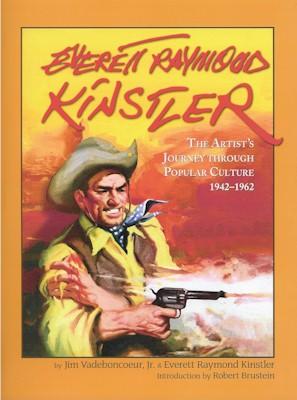 I don’t mind admitting it: to me, art is magic. Anyone who can sketch, draw, paint, or anything like that and actually make it look like something might as well be a wizard as far as I’m concerned. That’s how utterly beyond comprehension the process is to me.
I don’t mind admitting it: to me, art is magic. Anyone who can sketch, draw, paint, or anything like that and actually make it look like something might as well be a wizard as far as I’m concerned. That’s how utterly beyond comprehension the process is to me.
But just because I don’t know how they do it doesn’t mean that I don’t know what I like. (This is, of course, related to the old saying, “I don’t know much about art, but I know what I like.”) Which brings us around to the work of Everett Raymond Kinstler. It’s art, no doubt about that, and I like it.
Now known and widely respected as a portrait artist (he’s painted the official portraits of presidents and numerous other public figures), Kinstler got his start in the Forties as a comic book artist and later provided illustrations for pulp and paperback covers and dust jackets for hardcover books, in addition to many interior illustrations for pulp stories. This part of his life and career is examined in a beautiful new book from JVJ Publishing, EVERETT RAYMOND KINSTLER: THE ARTIST’S JOURNEY THROUGH POPULAR CULTURE, 1942 – 1962, written by Jim Vadeboncoeur Jr. and Kinstler himself.
The book begins with a long, well-written biographical essay that does a fine job of capturing the early years of a kid obsessed with art growing up in Manhattan during the Thirties. By the time he was sixteen, Kinstler was already a comics pro, starting out with inking other artists but quickly progressing to providing full art for various comics stories. He also managed to meet many of the major figures in the New York art world of the time, including giants such as James Montgomery Flagg. It makes for very interesting reading, even for someone like me who has never been artistically inclined.
Following that are sections that concentrate on the various aspects of Kinstler’s career, including comics, pulps, and paperbacks. There are page after page of beautifully reproduced illustrations, some of which prompted me to say to myself, “Hey! I have that book!” One of the most interesting features, at least to me, is a map of Manhattan in the Forties showing the locations of many of the comic book and pulp publishers located there.
Since the book concentrates on Kinstler’s work in popular culture, it wraps up as he is beginning his career as a portraitist. Impressively, Kinstler never tries to hide his background in pulps and comics. It seems that to him, it’s all art, regardless of where it appears, an attitude that I can certainly appreciate as a writer.
Before reading this book I was aware of Kinstler’s work, although not to the extent that I was of artists such as Frazetta, Krenkel, and my all-time favorite Robert McGinnis. I’d seen and enjoyed his art in many of the Western pulps I’ve read. Now I have an even greater appreciation for his work, and I’ll be looking for it from now on when I read pulps and vintage paperbacks. EVERETT RAYMOND KINSTLER is an excellent book, and congratulations to Jim Vadeboncoeur Jr. for producing it.
I've been writing quite a bit lately, so when it came time today to start a new book, I wasn't sure if I could muster up the mental energy to do so. Also, I had some other stuff to do this morning, so it was after lunch before I finally sat down to write. See how it goes, I told myself. Just see how it goes.It went well. I love starting a new manuscript. There's all that potential just waiting out there, the characters who weren't in the outline but come rampaging into the story anyway, the plot twists lurking, ready to jump out at me, that I don't even know about yet, and the nice lines that occasionally make me pause and grin for a second before I go on.I'm sure that before I'm done with it I'll be saying to myself, "Am I ever going to finish this damned thing?" But for now it's a pretty nice feeling.
Both of our kids are now off at college, and those of you who have gone through this know that it's an odd feeling. When public school started a couple of weeks ago (yes, they really start that early in Texas, but that's a rant for another time), it seemed strange that for the first time in 15 years it had no effect on our family. Now I'm torn between feeling proud that they're moving on and doing well, and remembering when they were toddlers playing in our front yard -- which couldn't be more than a year or two ago, surely.Well, before I get all misty-eyed like Maynard G. Krebs, I should move on and say that I've been writing a lot the past few days, trying to get a lot done while it was going well. I also finished Charles B. Stilson's A MAN NAMED JONES, which has an unfortunately bland title since it's actually a pretty good adventure novel. The title character is a young man who inherits a fortune from his father and therefore never has to work, so he becomes a rather dreamy sort, holed up in an apartment with a bunch of books. Then one day (and you knew something like this was coming), an old friend from college shows up with a fabulous uncut emerald, a photograph of a beautiful girl, and an enigmatic tale of adventure in the South Seas. The old friend conveniently drops dead, Jones becomes obsessed with finding the girl in the photograph, and before you know it he's off to the South Pacific where all sorts of exciting things happen. This has all the makings of a classic adventure story, and the fact that it never quite rises to that level can be traced to the fact that Stilson doesn't have the storytelling ability of an Edgar Rice Burroughs or H. Bedford-Jones, two authors who were already at work when this yarn was published in 1919. The pace is a little slow, especially in the first half, and the writing is pretty stilted at times. The second half is a corker, though, with plenty of action and some vivid, well-written scenes. I would have loved this book if I'd first read it when I was fifteen or so. As it is, I found it enjoyable and will definitely read the sequel, the better-titled LAND OF THE SHADOW PEOPLE.
Well, the heat wave didn't break, but I'm hoping that my writing slump did. I was able to get 21 pages done today, and I hope I can keep a similar pace going for a while.In his comment on yesterday's post, Cap'n Bob mentions air conditioners. We turn on our air conditioners (we have window units, not central air) in May -- April during a bad year -- and they don't get turned off for good until sometime in October. This makes for high electricity bills in those months, of course. And since we also have electric heating, the power company gets us coming and going. There are only a few months out of the year when our electric bill is relatively modest.While I'm not completely convinced by the arguments about the existence of global warming, I do believe there has been a climatic shift in the past 40 years or so since I was a kid. Back then, the really hot weather (100 degrees or above) started around the middle of June and lasted until about the first week in September. I don't mean it would be 100 degrees every day during that time, but such temperatures were common. Then in late September you might actually have a little cool weather. Now the really hot days don't start until July, but they last until the end of September. That same two-to-three week shift applies to winter weather, too. When I was young winter was over by the first of March. Now the threat of snow and ice in the first half of March pops up fairly often. I have no idea what causes this, and as usual when it comes to me and scientific theories, I may just be full of it.I'm still reading and enjoying Stilson's A MAN NAMED JONES.
We're in the midst of one of our summer heat waves. It's been over a hundred degrees for the past several days, with enough humidity to make the heat index even higher and no break in sight. Heat never bothered me much when I was a kid, but the older I get . . . I'm starting to wonder if the heat has fried my brain a little. My writing has slowed down somewhat. I need to be ripping through this current book pretty quickly. I'm still on schedule, but I hoped to get ahead by a few days. That may have to wait until the heat breaks, though.I'm reading one of those pulp reprints I talked about the other day, A MAN NAMED JONES by Charles B. Stilson. The writing is a little old-fashioned (big surprise there, it was first published in 1919), but the story moves right along.
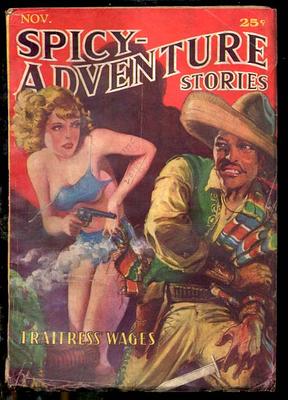 This is another pretty typical example of the Spicy genre. You can see why they were sold mostly under the counter.
This is another pretty typical example of the Spicy genre. You can see why they were sold mostly under the counter.
Sunday was our 29th wedding anniversary. To show you how special Livia really is, she figured out from reading my blog posts which of the 100 BULLETS trade paperbacks I didn't have and managed to come up with a copy of it somewhere.We spent our 20th anniversary working frantically on a book proposal that an editor in New York had to have the next day, so we had to finish it up and get it overnighted to him. The day before our 25th anniversary, another editor called and wanted some revisions written and emailed to him the next day. For one of the few times in my career, I said no to an editor and told him he'd just have to wait until the day after our anniversary for the revisions. The 29th was simpler, no writing crises or anything. The only problem was that our electricity went out for a while, the third time in less than a week that the power has been out.
 This week's WesternPulps scan is courtesy of Ed Hulse. It's a vivid cover and looks like a good issue, with stories by some of my favorites like Harry F. Olmsted, Walt Coburn, and Gunnison Steele. Popular Publications had not only some of the best covers on Western pulps, but some of the best titles, too. I mean, how can you not want to read "Legion of the Lost Frontier" or "The Derelict from Hell"?
This week's WesternPulps scan is courtesy of Ed Hulse. It's a vivid cover and looks like a good issue, with stories by some of my favorites like Harry F. Olmsted, Walt Coburn, and Gunnison Steele. Popular Publications had not only some of the best covers on Western pulps, but some of the best titles, too. I mean, how can you not want to read "Legion of the Lost Frontier" or "The Derelict from Hell"?
The word started going around this afternoon that Dennis Lynds has passed away. This is terrible news, and very unexpected, at least by me. Dennis was a guest on the Rara-Avis list a few months ago and seemed as eloquent and enthusiastic as ever.One of the nice things about being a writer is that you sometimes get to meet your heroes, or at least correspond with them. The first book I ever read by Dennis Lynds was probably THE SHADOW STRIKES, published by Belmont Books under the Maxwell Grant house-name in the mid-Sixties. Of course, at the time I had no idea that in this case Maxwell Grant was really a writer named Dennis Lynds. All I knew was that I had listened to reruns of the Shadow radio show and loved it, and now here was a book about the character. (I was only dimly aware of pulps then and had little if any knowledge of the Shadow's history.) I thought the book was great and picked up all the other Shadow novels that Belmont published over the next few years. All of them, I learned later, were really by Dennis Lynds.Later I read some of his Three Investigators novels, written under the name William Arden, and I read all the Man From U.N.C.L.E. novellas published in the digest magazine under the name Robert Hart Davis, and again, I loved them without knowing that some of them were by Dennis Lynds. I didn't really know who he was until the late Seventies, when I started buying the Dan Fortune novels that he wrote as Michael Collins, as well as reading his short stories in various mystery digests. My friend Tom Johnson knew Dennis because Tom had a nearly complete collection of MIKE SHAYNE MYSTERY MAGAZINE, and Dennis wrote the Mike Shayne novellas as Brett Halliday for about seven years during the Sixties. Tom corresponded with Dennis and put me in touch with him, and as a fledgling writer in the early Eighties, I found myself trading letters with an author whose work I had read extensively and always enjoyed. Dennis was an Old Pro, even then, and he consistently gave me some of the best writing advice I ever got.We drifted out of touch over the years, as often happens, but I continued to read and enjoy Dennis's books. One afternoon some years ago, the phone rang and on the other end was Gayle Lynds, Dennis's wife, who at that time was about to launch her very successful career as an author of suspense thrillers. I don't remember now why Gayle called, but I know we had a pleasant conversation and I even talked briefly with Dennis, the only time we spoke. I'm glad we had that chance, and I'm glad we got to trade a few emails while he was on Rara-Avis. He was a great writer and a fine man, and he will definitely be missed.
 Another SPEED WESTERN cover, this one from an issue that featured a story by an author I like, the inconsistent but often quite good T.W. Ford.
Another SPEED WESTERN cover, this one from an issue that featured a story by an author I like, the inconsistent but often quite good T.W. Ford.
Speaking of pulp reprints, which I was a few days ago, I recently got a stack of them from my friend Brian Earl Brown, who is also the editor of PEAPS, the pulp apa. Brian publishes affordable reprints of rare and classic pulp serials under his Beb Books imprint, usually bringing out several titles each summer. This year I picked up:TALES OF SHEENA, QUEEN OF THE JUNGLE, which consists of three novelets from the one-shot pulp of the same name, plus a fourth story that appeared later in JUNGLE STORIES.A MAN NAMED JONES and LAND OF THE SHADOW PEOPLE, a pair of linked novels by Charles B. Stilson that originally appeared in the pulp ALL-STORY WEEKLY in 1919 and 1920. Stilson was one of the earliest authors influenced by Edgar Rice Burroughs and is most famous for a trilogy of novels about the character Polaris of the Snows. (Those stories were reprinted by Brian last year and are still available.)PALOS OF THE DOG STAR PACK, THE MOUTHPIECE OF ZITU, and JASON, SON OF JASON, all by J.U. Giesy, another early ERB-imitator. These stories were published in ALL-STORY WEEKLY in 1918, 1919, and 1921 respectively. (Note that by the time the third story came out, the name of the pulp had changed to ARGOSY ALL-STORY WEEKLY, an early merger of two pulps.)I'm looking forward to reading all of these, although I usually have to be in the right mood to read stories this old. I believe most if not all of the books Brian published in years past are still in print. These include titles by Frank L. Packard (the Jimmie Dale series, which I read many, many years ago in the Gray Seal editions) and Perley Poore Sheehan, a well-known early pulpster. For information about any of them, you can e-mail Brian directly at beb01@sprynet.com .
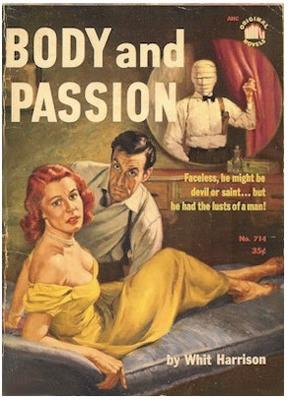 I'm still reading the trade paperbacks that reprint Brian Azzarello's very hardboiled comic book series 100 BULLETS. One of them, THE COUNTERFIFTH DETECTIVE, features as its protagonist a private eye who is so badly injured in a car wreck that his face is covered with bandages.That immediately reminded me of one of my favorite novels by the great Harry Whittington, writing in this case as Whit Harrison. It has a very striking cover, which you can see above, and a fascinating plot. Allow me to quote from the blurb inside the front cover:Out of a flaming holocaust which had been an isolated fishing shack walked the figure of a man . . . a man who had no features that were recognizable, no memory of who he was or what he had done. He might be a brilliant young lawyer with a future of glory and riches waiting for him. Or he might be a man wanted for murder, with nothing waiting for him but the electric chair . . . and the whole-hearted, unswerving devotion of a beautiful young girl. They called him X, and they left him to work out his fate in a morass of ambition and greed.Now, if you can read that and not want to dive right into the story, you're made of sterner stuff than I am.
I'm still reading the trade paperbacks that reprint Brian Azzarello's very hardboiled comic book series 100 BULLETS. One of them, THE COUNTERFIFTH DETECTIVE, features as its protagonist a private eye who is so badly injured in a car wreck that his face is covered with bandages.That immediately reminded me of one of my favorite novels by the great Harry Whittington, writing in this case as Whit Harrison. It has a very striking cover, which you can see above, and a fascinating plot. Allow me to quote from the blurb inside the front cover:Out of a flaming holocaust which had been an isolated fishing shack walked the figure of a man . . . a man who had no features that were recognizable, no memory of who he was or what he had done. He might be a brilliant young lawyer with a future of glory and riches waiting for him. Or he might be a man wanted for murder, with nothing waiting for him but the electric chair . . . and the whole-hearted, unswerving devotion of a beautiful young girl. They called him X, and they left him to work out his fate in a morass of ambition and greed.Now, if you can read that and not want to dive right into the story, you're made of sterner stuff than I am.
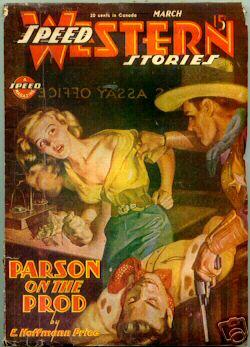 The Spicy pulps eventually cleaned up their act (a little) and changed over to SPEED WESTERN, SPEED MYSTERY, etc. Here's a SPEED WESTERN cover that also features an E. Hoffmann Price story.
The Spicy pulps eventually cleaned up their act (a little) and changed over to SPEED WESTERN, SPEED MYSTERY, etc. Here's a SPEED WESTERN cover that also features an E. Hoffmann Price story.
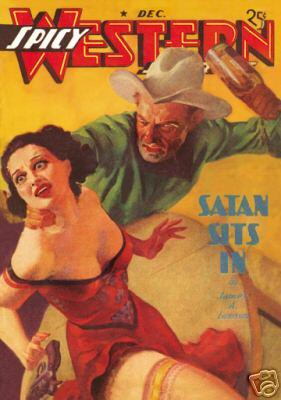 Here's another SPICY WESTERN cover, from December 1937. This particular issue is available as a facsimile reprint from Girasol Collectibles and can be purchased on eBay. I've seen some of the Girasol reprints, and they're really nice.
Here's another SPICY WESTERN cover, from December 1937. This particular issue is available as a facsimile reprint from Girasol Collectibles and can be purchased on eBay. I've seen some of the Girasol reprints, and they're really nice.
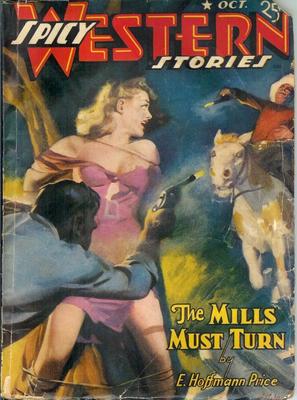 Here's the only other SPICY WESTERN cover scan I can find right now, but I know I have some more around here somewhere. This issue featured a story by that prolific pulp author E. Hoffmann Price. If any of you want to actually read some stories from the Spicy pulps, you can find quite a few on Larry Estep's magnificent Pulpgen website, most of them from SPICY DETECTIVE and SPICY MYSTERY. There are also hundreds of other downloadable PDFs of stories from a wide variety of pulps. I can't recommend this site highly enough. It's given me many hours of entertainment.
Here's the only other SPICY WESTERN cover scan I can find right now, but I know I have some more around here somewhere. This issue featured a story by that prolific pulp author E. Hoffmann Price. If any of you want to actually read some stories from the Spicy pulps, you can find quite a few on Larry Estep's magnificent Pulpgen website, most of them from SPICY DETECTIVE and SPICY MYSTERY. There are also hundreds of other downloadable PDFs of stories from a wide variety of pulps. I can't recommend this site highly enough. It's given me many hours of entertainment.
You've got to give Robert B. Parker credit. When he wants to write a Western, he writes a Western, and he's got the clout to get it published and the readership to get it on the NY Times bestseller list. APPALOOSA isn't a revisionist, politically correct Western, either. Other than a slightly higher level of cussin', it's about as traditional as you can get. It's a town tamer novel, about a couple of lawmen, Virgil Cole and Everett Hitch (who narrates the book), and the trouble they have bringing an arrogant cattle baron to justice when he and his men start running roughshod over the town of Appaloosa.I liked this book, then didn't like it much, and finally wound up thinking that it's pretty good. The familiar Parker shtick of having the characters sit around and appear to be talking about one thing while they're really talking about something else is starting to wear thin for me, and many of the scenes appear to be lifted from various Western movies -- some RIO BRAVO here, a dash of 3:10 TO YUMA there -- but the gunfights are well-written and you can't help but like and root for Cole and Hitch. It also helps that Parker creates one of his least sympathetic female characters in this book. Other than being annoying, Parker's female characters often seem to me a little too good to be true. And as usual with Parker, the book is short and reads really fast, another plus as far as I'm concerned.I've liked both APPALOOSA and GUNMAN'S RHAPSODY, Parker's previous Western. If he wants to keep writing them, that's fine with me.
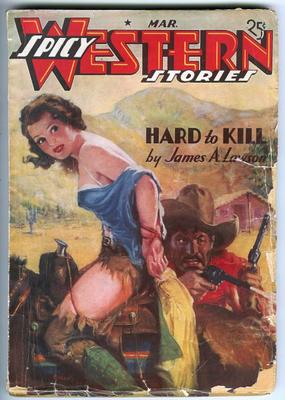 Here's one I like. I don't actually own any issues of SPICY WESTERN, but I have a few cover scans. The story in this issue, "Hard to Kill" by James A. Lawson, is probably one of a series featuring a character named Dallas Duane, who works as a troubleshooter for an oil company. Despite the fact that the series was published mostly in SPICY WESTERN (and a few other Western pulps), the stories are actually mysteries. Just imagine Dan Turner working in rough West Texas oil boom towns in the Thirties, and you've got the Dallas Duane series. Some of them were reprinted recently in chapbook format by Tom Roberts of Black Dog Books, and I highly recommend that volume. Great fun.
Here's one I like. I don't actually own any issues of SPICY WESTERN, but I have a few cover scans. The story in this issue, "Hard to Kill" by James A. Lawson, is probably one of a series featuring a character named Dallas Duane, who works as a troubleshooter for an oil company. Despite the fact that the series was published mostly in SPICY WESTERN (and a few other Western pulps), the stories are actually mysteries. Just imagine Dan Turner working in rough West Texas oil boom towns in the Thirties, and you've got the Dallas Duane series. Some of them were reprinted recently in chapbook format by Tom Roberts of Black Dog Books, and I highly recommend that volume. Great fun.
 This week's WesternPulps scan is from WESTERN STORY, the granddaddy of all Western pulps. It's a bit unusual to see even a hint of bondage on a pulp published by Street & Smith. It's not like this is SPICY WESTERN or something. (Of course, I do have some cover scans from SPICY WESTERN, and I probably ought to post them someday . . . )
This week's WesternPulps scan is from WESTERN STORY, the granddaddy of all Western pulps. It's a bit unusual to see even a hint of bondage on a pulp published by Street & Smith. It's not like this is SPICY WESTERN or something. (Of course, I do have some cover scans from SPICY WESTERN, and I probably ought to post them someday . . . )
Of course, before finishing the manuscript mentioned below, I encountered some trouble. I was sitting in my office, typing along, when suddenly there was a huge clap of thunder and my computer and monitor both went dead. Now, I knew there was a storm coming in, but there hadn't been any thunder so far. The lightning bolt that struck right by my office was the first one of the afternoon.I had no idea whether or not my computer was fried, but naturally I assumed the worst. I use that computer only for writing and it wasn't that expensive, but I didn't want to lose all the data stored on it. I save my work on the computer's hard drive, on a floppy drive, and on a jump drive that I carry around with me. I had saved the file on the hard drive just a minute or so before, but not on the floppy or the jump drive. I carried the floppy into the house to check and see how much of the file was on it, and I found that it was eight pages short of the point I was at in the writing. I hate losing pages and having to recreate them, so I did a lot of angry muttering as I walked back out to the office.When I got there, though, I noticed that the CD player that was also plugged into the same UPS as the computer and monitor was also dead. So I kept my fingers crossed that it was the UPS that was fried, not the computer. I unplugged the computer and monitor from the UPS, plugged them directly into wall sockets, and lo and behold, the computer came back on. The UPS was also a surge protector, and it did its job, saving the computer from being ruined. I wound up losing only a couple of paragraphs, and that was no big deal. If I had lost the whole eight pages, I'm sure I would have been so disgusted that I wouldn't have finished the book today.
I've been writing pretty hard this week, trying to finish the current manuscript by August 10, as Bill Crider predicted last month. However, I didn't make it. I didn't wrap it up until today, and I still have to do a little editing and polishing on the last chapter or so. And then Livia will take over and polish some more. I'll have to decide whether to start the next one tomorrow or wait until Saturday.
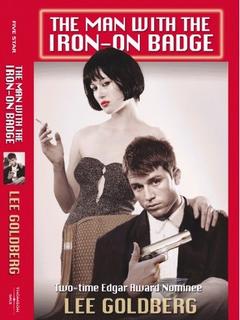 Lee Goldberg is best known, of course, as a television writer and producer, as well as the author of the very active blog A Writer’s Life. But he’s also a novelist, and his latest, THE MAN WITH THE IRON-ON BADGE, is well worth your attention.
Lee Goldberg is best known, of course, as a television writer and producer, as well as the author of the very active blog A Writer’s Life. But he’s also a novelist, and his latest, THE MAN WITH THE IRON-ON BADGE, is well worth your attention.
It’s the story of Harvey Mapes, a security guard at an exclusive, gated Southern California housing development. Harvey is also a fan of mystery fiction and spends most of his hours in the guard shack reading old paperbacks and wishing he could be more like Travis McGee. Harvey’s life changes when he is hired by one of the residents of the development to do some amateur private detective work and finds himself involved in something that at first glance would be right at home in one of the old Gold Medal novels he’s read.
This book starts out as a fine example of the humorous “lovable schmoe” school of detective fiction, and Goldberg does a good job with that part of it, but then it takes a sudden turn into darker and more dangerous territory and becomes even better. The plot becomes more complex and so do the characters, and while Goldberg plays scrupulously fair with his clues, nothing and nobody turns out be exactly that they seemed at first. Add to that some very smooth prose and a sense of compassion for the people he’s writing about, and you’ve got one of the best books I’ve read so far this year. Highly recommended.
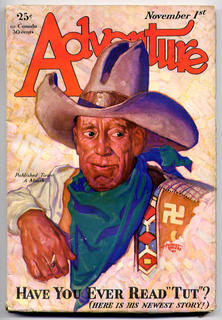 Here and on the WesternPulps group, I've posted this scan of the cover from which last week's cover was "swiped". This is the November 1, 1929 issue of ADVENTURE. You can see last week's scan, from SHORT STORIES, July 25, 1938, here. The ADVENTURE artist is Hubert Rogers. The SHORT STORIES cover is by A.L. Tilburne. Thanks to Ed Hulse for the information and for this cover scan. (By the way, the "Tut" referred to on the cover is Western author W.C. Tuttle, whose work was a staple in many pulps, including ADVENTURE.)A common argument in pulp fandom is over which was the best general fiction pulp: ADVENTURE, ARGOSY, or BLUE BOOK. I'm sort of an ARGOSY man myself, although there are times when I prefer BLUE BOOK. However, ADVENTURE was a fine pulp, too, and I've enjoyed every issue I've ever read of it. You can't go wrong with any of those big three, as far as I'm concerned.
Here and on the WesternPulps group, I've posted this scan of the cover from which last week's cover was "swiped". This is the November 1, 1929 issue of ADVENTURE. You can see last week's scan, from SHORT STORIES, July 25, 1938, here. The ADVENTURE artist is Hubert Rogers. The SHORT STORIES cover is by A.L. Tilburne. Thanks to Ed Hulse for the information and for this cover scan. (By the way, the "Tut" referred to on the cover is Western author W.C. Tuttle, whose work was a staple in many pulps, including ADVENTURE.)A common argument in pulp fandom is over which was the best general fiction pulp: ADVENTURE, ARGOSY, or BLUE BOOK. I'm sort of an ARGOSY man myself, although there are times when I prefer BLUE BOOK. However, ADVENTURE was a fine pulp, too, and I've enjoyed every issue I've ever read of it. You can't go wrong with any of those big three, as far as I'm concerned.
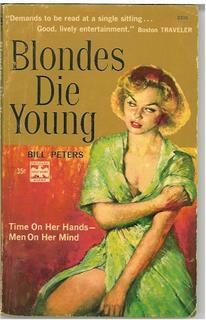 A few days ago, Bill Crider and Ed Gorman discussed this novel by William P. McGivern (under the pseudonym Bill Peters), so I decided to read it, too. I’ve had two copies of it, the original paperback edition and a later edition (pictured), on my shelves for years, long enough that I don’t remember where or when I got them.
A few days ago, Bill Crider and Ed Gorman discussed this novel by William P. McGivern (under the pseudonym Bill Peters), so I decided to read it, too. I’ve had two copies of it, the original paperback edition and a later edition (pictured), on my shelves for years, long enough that I don’t remember where or when I got them.
This is a good hardboiled novel about Philadelphia private eye Bill Canalli, who goes to visit a girl in Chicago and winds up in the middle of a vengeance quest to bust up the largest drug ring in the Midwest. I know it’s a cliché, but I like a private eye book where the hero gets hit on the head, and Canalli gets clouted several times in this one. There’s plenty of action, some nice observations on human nature, and a twisty plot. The surprise ending isn’t really much of a surprise, but it’s still effective. This is actually the first mystery novel by McGivern that I’ve read (I read his World War II novel SOLDIERS OF ’44 several years ago). BLONDES DIE YOUNG is good enough that I want to read more of his hardboiled stuff.
Here's an e-mail I got today, prompted by a previous post on Harold Bell Wright, one of those "Forgotten Authors" I write about every now and then.July 9, 2005 Press Release - For Immediate ReleaseFrom The Family of Harold Bell WrightThe Family of Harold Bell Wright is pleased to offer for sale the original metal bookplates of the 1932 novel, Ma Cinderella, written by America's Great Storyteller, Harold Bell Wright. These are technically known as stereo plates, which are the type in reverse.They were put on a rotary printing press to print the book.During World War 2, the federal government required book publishers to"donate" old bookplates in order to use the metal in the war effort. HarperBrothers, which published Ma Cinderella, offered HBW the opportunity to purchase the plates, which he did. The money went to the government. The Family assumes that the plates of his other books were previously destroyed and not available for purchase by the Author.The Family is offering these bookplates to the fans of Harold Bell Wright for the price of $35.00 each. This price will include all shipping and insurance charges. To purchase Ma Cinderella Bookplates, please send check or money order made payable to "The Family of Harold Bell Wright" for $35.00per plate. Limit 5 per household/business (there is no discount for multipleorders). Send your check and order to: The Family of Harold Bell Wright, Post OfficeBox 1591MC, Burbank, Ca. 91507-1591. There is a limited number available and the orders will be honored as received. Pictures of representative plates are available. The size of each plate is approximately 3 3/8" X 5 7/8" with the book title at the top of each page and page number. Specific pages can be requested for an additional $15.00 per page. If the requested page is not available, the $15.00 will be refunded. This is the first and only time the Family of Harold Bell Wright will offer the bookplates and other items for sale and auction.Immediately following the Ma Cinderella bookplates sale, the Family of Harold Bell Wright will begin a sealed bid auction of other HBW artifacts and memorabilia. There will be no Buyer's Premium charged, as is customary with most auctions. However, shipping and insurance will be added to the price of each successful auction purchase. Some of the items that will be offered at the auction include the title, dedication, chapter heading pages and other special pages from Ma Cinderella; fishing creel and rod owned by HBW along with a framed pictureof HBW using these items in the Ozarks; wrought iron lamps, candle sticks and candelabras - all handmade by HBW; a set of mounted Texas Longhorns; oneof Harold Bell Wright's traveling writing desks; camping items; water canteens; painting easel; a leather Doctor's bag; several pairs of his glasses and cases; household items, blue glass from the same collection that is featured in the HBW Museum in Missouri; crystal; china; ceramic dishes; monogrammed linens; tablecloths; napkins and many other collectible items including a leather monogrammed sewing kit that belonged to Winnie Wright;and possibly many Native American items he collected while living in Arizona. There will also be books from his personal library including highly collectible "Association" books - books written by contemporaries inscribed by the authors as gifts to Harold Bell Wright. The family has more than 1500 books that are known to have come from HBW's personal library. There are also antique and rare maps in the collection as well. A list of the more collectible and rare books and sets will be available by July 12th. Books dated back to the early 19th century are in the collection. There will also be offered a signed black and white portrait photograph ofWinnie Wright taken by Edward Weston. The Weston Gallery has appraised this photograph at $8,000.00 We also have a signed photograph of John Barrymore that we can date to circa 1925. Most items are expected to sell for less than $200.00 with lots of items in the $50 to $100.00 range. Some items will have reserves and if the reserves are not met, they will not be sold. To order the auction catalog which will include pictures of most items being offered, please send $5.00 by check or money order, made payable to "The Family of Harold Bell Wright" c/o Post Office Box 1591AC, Burbank, Ca.91507-1591. The purchase price will be deducted from any successbid/purchase from the catalog. The catalog will be available for purchase on July 15, 2005 and the auction will be concluded on or about September 30, 2005 and the winning bidders will be notified. After the auction, all items still available will then be offered for sale at a final Estate Sale to take place in Burbank, California the third weekend of October 2005. After that point, any remaining items and books will be donated to the University of Arizona where HBW's personal papers are housed or to other charities of the family's choice. Also available will be Persian rugs from the Tucson House and HBW's SteinwayPiano (circa 1915), which he purchased for the Tucson Home. Also, a complete bedroom set that Winnie purchased for the San Diego house will be offered for sale. (THESE ITEMS WILL REQUIRE PICK UP OR SPECIAL SHIPPING/HANDLING CHARGES.) Many of the items for sale are seen in pictures that the family has from HBW's life. When a picture is available, a copy will be included with thepurchase. Certificates of Authenticity will be issued with each purchase and/or successful bid. IF YOU KNOW SOMEONE WHO SHOULD GET THIS NOTICE BY EMAIL OR SNAIL MAIL, PLEASE LET US KNOW ASAP.
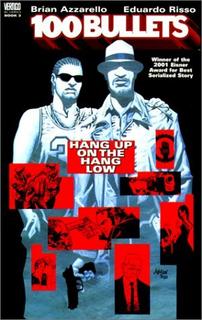
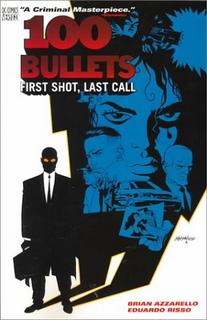 I thought I might catch up a little tonight and talk about several books I’ve read recently, as well as the one movie we’ve watched lately.
I thought I might catch up a little tonight and talk about several books I’ve read recently, as well as the one movie we’ve watched lately.
THE COMPLETE WESTERN STORIES OF ELMORE LEONARD is a massive volume collecting all thirty of Leonard’s Western stories, from his first appearances in magazines like DIME WESTERN and ARGOSY at the tail end of the pulp era to a few stories that appeared in anthologies later on. Since I’m on record as liking Leonard’s Westerns better than his crime stories – and his earlier stuff better than his later work, for that matter – it’s no surprise that I really liked this book. All the stories have plenty of good dialogue, Leonard’s trademark, and the plots are tight and focused, rather than sprawling all over the place. The characters aren’t clear-cut good and bad but generally have some real depth. The only real drawback to this book is that almost half the stories have appeared relatively recently in Leonard’s other collections, THE TONTO WOMAN AND OTHER STORIES and WHEN THE WOMEN COME OUT TO DANCE. Still, having them all in one place makes for a really fine volume.
I’ve read a couple of trade paperbacks reprinting story arcs from the Vertigo (DC’s mature readers imprint) comic book series 100 BULLETS. This is a very hardboiled series set in various sectors of the criminal underworld, but the stories play out against an enigmatic backdrop of a developing “mythology” concerning a mysterious cabal that really runs the country. The set-up is fairly simple: a man calling himself Agent Graves shows up and gives somebody who has been wronged an attaché case containing an automatic and a hundred untraceable bullets. Whoever gets the gun can do whatever they want with it and get away with their actions. Of course, things never turn out to be that simple. I’m missing the second volume, but I’ve read #1, FIRST SHOT LAST CALL, and #3, HANG UP ON THE HANG LOW. I wasn’t sure about this series at first. The scripts by Brian Azzarello feature great dialogue and lots of plot twists, but they’re unrelentingly grim. And the highly stylized art by Eduardo Risso isn’t really the sort that a traditionalist (old fogey) like me is used to. But by the time I was finished with HANG UP ON THE HANG LOW, I was hooked on this series and I’m glad I have several more of them on hand to read. Although Azzarello doesn’t use captions in his scripts, like a lot of current comics writers, the dialogue flows so naturally it’s really a pleasure to read. And even Risso’s art is growing on me. I’d recommend these to any readers of hardboiled fiction.
Moving from the current to the old-fashioned, I also read MONTANA RIDES AGAIN, by Frederick Faust writing as Max Brand writing as Evan Evans. (If you’re a Faust fan you understand that byline; if you’re not . . . well, don’t ask.) This is a second book in a trilogy that also includes MONTANA RIDES! and THE SONG OF THE WHIP. I liked it a lot, and a review of it will probably show up here eventually, after I’ve used it in my apazines.
Now for the movie. We watched MILLION DOLLAR BABY a few days ago. I enjoyed it, thought it was well-written and very well acted for the most part, and Clint Eastwood’s direction was nice and understated. It was very refreshing to watch a movie that depended on the script, the actors, and the direction rather than on a ton of CGI. In fact, I wonder if maybe that had something to do with its success, if it benefited from a little backlash against flashy, special effects laden extravaganzas. Not that it didn’t deserve its acclaim, but maybe it wasn’t quite really as good as it seemed by comparison. My only real complaint about it is that too much of the dialogue was mumbled or whispered or otherwise inaudible. Maybe that’s more realistic than actors’ delivery used to be, but I don’t care. I still want to hear what they’re saying.
I’ve hit the 100 page mark in the current manuscript, 106, to be precise, but I’m not going to be finished by August 10. When I finished work for today, I got to the end of a scene, wrote the first few lines of the next scene, and then stopped in mid-sentence. I’ve heard writers recommend this trick as a way of getting started easier the next day, but the truth is I hardly ever do this. Occasionally I will, though. More often I stop at the end of a scene, or the end of a chapter if possible. Sometimes I’ll write a little prompt for what’s coming up next, no more than a line or two, in all-caps right there at the end of that day’s text. Then I delete it the next day and go on. But none of these little tricks are rules with me. I just do whatever feels right at the time. Which makes me think that maybe the only real writing rule is: Do whatever works.
I’m currently reading BLONDES DIE YOUNG by Bill Peters (William P. McGivern). I know Bill Crider and Ed Gorman have already talked about this book recently, but you’re going to have to wade through my comments on it, too. Or not.
Today was one of those days that involved lots of driving from place to place and getting in and out of the van in heat, humidity, and a Level Red pollution alert. That said, it was tiring but not too bad. We had to go to a couple of libraries to return books (and get more, including Robert B. Parker's new Western, APPALOOSA). We also stopped at Half Price Books and I found a book called THE UNEXPECTED, an early Sixties Pyramid Books anthology of short stories originally published in WEIRD TALES. This was edited by the semi-legendary Leo Margulies, who edited several other paperback anthologies of WEIRD TALES stories that I've read and enjoyed. One of the previous owners of this particular book wrote "Very Funny" on the Table of Contents page under the title of the Robert Bloch story. I'll probably agree, since I usually like Bloch's stories. We also went to Wal-Mart, where I picked up a couple of boxed sets of old Western movies from the bargain DVD bin. One set has eight Gene Autry movies in it, the other has an assortment of Three Mesquiteers, Cisco Kid, Ken Maynard, etc. I'm not a big Gene Autry fan -- I always liked Roy Rogers a lot better -- but most of Gene's movies are watchable if you can forgive the fact that he couldn't ride very well and had a hard time with the action scenes.
Here's an odd website with some vintage paperback content that might be of interest to some. Thanks to Duane Spurlock for the link.















